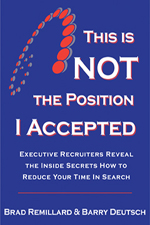Effective Networking Step 3 – Stop Meeting People
So many candidates misunderstand effective networking. They really don’t even understand networking. Many think networking is all about meeting people. The more you meet, the better the network. This is one of those misguided themes that lead many people to frustration.
Effective networking isn’t about meeting people. It is about meeting the right people. I have written on this before.
One hundred of the right people in your database is worth more than 1,200 people who can’t help you.
A common misunderstanding that I hear all of the time from candidates is, “Networking is about helping others.” I do agree with this and believe it is important. However, this isn’t the main reason for networking. The fact is, you are networking to help you. This is why most people (95%) stop networking once they land a new position.
Here are a few tips to help you effectively network with the right people:
- Do some research on the types of people you want to meet and why you want to meet them. This could be by function, industry, service providers, or associations. This list should be comprehensive. Don’t waste time meeting people unless they meet this criteria or are no more than 1 degree removed from this list.
- Research how to meet the people on this list. Identify who they come in contact with, ask people who they might know on the list, attend meetings consistent with these people’s background or industry. Focus like a laser beam on meeting these people.
- Network with a purpose. You should always ask yourself, “Why do I want to spend time with this person?” What’s in it for you? If nothing, either don’t waste the time or at least do it around your schedule and location.
- Do your research before meeting a person. Look at their contacts on LinkedIn, identify who they are connected with that are on the list from #1, bring your list of people that you want them to introduce you to, prepare what questions you have for them, be prepared to open your contacts to them and make a referral to help them, and understand why you want to spend time with them.
- Have a plan to keep in touch with them to develop a relationship. In the meeting, probe to identify their interests so you can engage them later around these interests.
- Ask them to bring their contacts with them to the meeting and you should also bring yours. This way you can help each other on the spot. The effectiveness of additional referrals drops significantly after the meeting. This is why you are meeting, so take full advantage of it.
- Stay focused on your list. Don’t stray from it. These are the people you have identified as the people that can best help you find a job. Instead of wasting time with those that can’t help you, spend the time focusing on how to connect with those that can. This is far more valuable.
The best way to effectively network is to meet the right people. This sounds so obvious, however, I have discovered like many things most candidates “know this” but don’t actually practice it. If they did, then I and many others wouldn’t be writing on it so often.
I find over and over again those candidates that stay focused on meeting the right people not only find a job faster, but also enjoy networking more than those that just meet people. I believe this is because they see results.
Expand your online network by joining our LinkedIn Job Search Networking Group of 5,300 members and growing. There are many articles and resources in this group to help you. CLICK HERE to join.
You can also download free cover letter and thank you letter examples. These have both been proven to be very effective. CLICK HERE and then scroll down to the What’s New Section at the bottom.
I welcome your comments and feedback.
Brad Remillard





